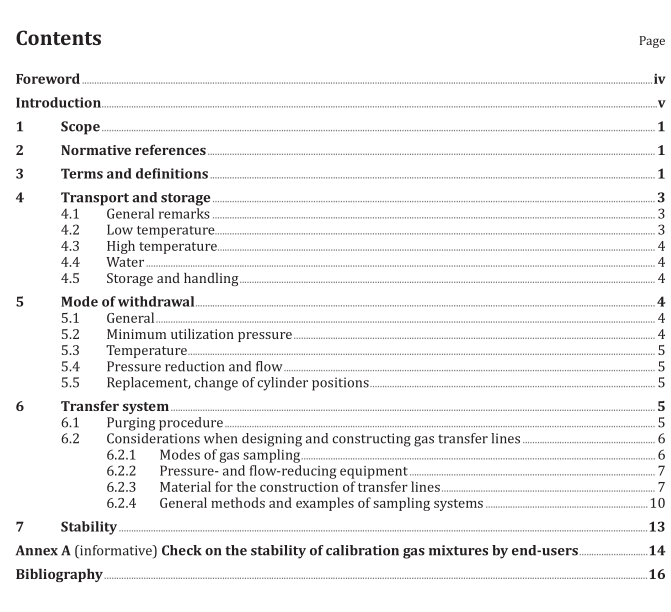ISO 16664 pdf download

ISO 16664 pdf download Gas analysis — Handling of calibration gases and gas mixtures — Guidelines
3 Transport and storage
3.1 General remarks After preparation of the calibration gas, the gas cylinder will be transported to the user. The environment in which the cylinders are transported is not normally regulated in terms of temperature and humidity. Low temperatures may have a detrimental impact on the mixture composition, especially when condensable components are present in the mixture. As a consequence of this, environmental conditions during transport and storage should never exceed those recommended by the manufacturer. Gas cylinders and especially cylinder valves shall be free of grease and other lubricants. During storage and transportation, cylinder valves shall be closed, sealing nuts shall be tightened and protection caps shall be attached. The gas cylinders are transported in several ways, e.g. by air, railway, road and on water. In some specific cases, the temperature restrictions may be such that not every means of transport is acceptable.
3.2 Low temperature The gas cylinder may be exposed to low temperatures during storage and transportation. For gas mixtures containing condensable components, it is important that the cylinder is not stored or transported at temperatures below those recommended by the manufacturer. If the mixture is exposed to temperatures below the stated range, some components may condense and this will change the composition of the mixture.
If the mixture has been exposed to temperatures lower than those recommended by the manufacturer, the certificate from the manufacturer is no longer valid. In this case, it is very important that the mixture shall not be used before the manufacturer is asked for further advice. He may advise homogenizing the mixture before usage.
3.3 High temperature Avoid high temperatures (heating) close to the cylinder, e.g. from welding flames, blowlamps, ovens or other intensive heat sources. High temperatures will result in higher pressures leading to potentially hazardous situations. In addition, elevated temperatures may result in decomposition of thermally unstable species. 3.4 Water Gas cylinders shall be protected from excessive humidity during transport. Transportation by boat may result in the cylinder being sprayed with water; this and/or excessive humidity may cause corrosion of the cylinder valve. Always protect the cylinder from precipitation to prevent corrosion. If the cylinders are stored outdoors protected by a roof, the cylinder base should also be protected from water accumulating on the floor by raising it above the ground.
3.5 Storage and handling
The best way to store calibration gas mixtures for a longer period is by laying the cylinders in a horizontal position, well protected against rolling and falling. For safety reasons, it is necessary to separate cylinders containing flammable gases from cylinders containing oxidizing components. WARNING — For general safety reasons, never heat cylinders above 45° C. Mixtures containing condensable components may require rehomogenization if stored for longer periods of time and if exposure to temperatures below the condensation point cannot be excluded. This may be done by bringing up the cylinders to ambient temperature and rotating them into a horizontal position for an appropriate period of time, which may depend on the matrix gas and the components (see 4.2).
NOTE After rehomogenization, it is necessary to contact the manufacturer in order to verify the validity of the calibration gas.
4 Mode of withdrawal
4.1 General In the withdrawal of the gas from the cylinder through the transfer system, a number of aspects shall be considered.
4.2 Minimum utilization pressure The information attached to the cylinder indicates, if applicable, a pressure value below which the gas should not be used. It has been reported that in some cases under a certain pressure, gas molecules that were attached to the cylinder wall come off this cylinder wall when the cylinder pressure drops, resulting in a higher mole fraction. NOTE In addition to this effect on the stability of the gas mixture, it is important from the point of view of the manufacturer that a cylinder is not completely emptied, as the cylinder could then be contaminated with environmental air. This especially applies to specially treated cylinders where stability is an issue.









